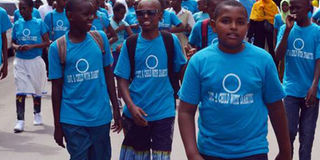Summit to boost measures in combating diabetes

Children take part in a diabetes walk in Mombasa on July 25, 2015. In Kenya, diabetes affects over 25,000 children and over 700, 000 adults, according to the International Diabetes Federation (IDF). PHOTO | KEVIN ODIT | NATION MEDIA GROUP
What you need to know:
- The meeting, held in Nairobi on Saturday, drew more than 100 doctors and diabetes specialists from 10 Sub-Saharan countries.
- The young and middle-class Kenyans are more susceptible to this non-communicable disease owing to their poor lifestyle habits.
Efforts in controlling and treating diabetes have been intensified following a convention by medics discussing innovative ways to address the disease.
The meeting, held in Nairobi on Saturday, drew more than 100 doctors and diabetes specialists from 10 Sub-Saharan countries.
The Middle Africa Premix Summit, the first of its kind, analysed the latest data on the different treatment options and guidelines for insulin initiation, which is key in diabetes management.
Participants attending the one-day event also examined the dilemmas facing clinicians and patients in Africa as they commence treatment in comparison to other regions.
In Kenya, diabetes affects over 25,000 children and over 700, 000 adults, according to the International Diabetes Federation (IDF).
The Ministry of Health shows 10 in every 100 diabetics are children; and because this condition is diagnosed late, the victims die prematurely, especially those from poor backgrounds which cannot afford the treatment costs, the Kenya Diabetes Management and Information (DMI) Centre says.
Odds are still not in their favour if they survive for they may have to live with damaged organs such as the heart, blood vessels, eyes, kidneys and nerves.
The young and middle-class Kenyans are more susceptible to this non-communicable disease owing to their poor lifestyle habits such as eating of junk food and leading sedentary lifestyles.
Hence, they are prone to hypertension and high blood pressure, among others.
Dr Eve Njenga, an Endocrinologist, discussed the available modern treatment for diabetes in the country.
“For diabetes for instance, this burden is related to health system costs incurred by society in managing the disease, indirect costs resulting from productivity losses due to patient disability and premature mortality and time spent by family taking [care] of patients,” Dr Njenga said.
IDF estimates that diabetic patients require up to three times more in health care resources compared to non-diabetics.
PATIENT CARE
The summit organiser, Mr Venkat Kalyan from Novo Nordisk — a global health care company— underscored that care for diabetic patients is vital.
Mr Kalyan said: “At Novo Nordisk, we believe in doing what is best for the patients. That is why better access to diabetes care is an integral part of our core business and therefore also essentially the agenda of this summit.”
There are two major forms of diabetes: Type 1 diabetes, which is common in children and young people, is characterized by lack of insulin production by the pancreas. But its cause is unknown.
Type 2 diabetes, the most rife and often preventable, results from the body's ineffective use of insulin.
Insulin is a hormone that helps glucose get from the blood into body cells where it is converted into energy.
In sufferers, the pancreas makes little or no insulin or body cells cannot utilise the insulin effectively.
Glucose, therefore, cannot get into the cells and builds up in the blood.
If blood glucose stays too high it can damage different parts of the body such as the heart, eyes, kidneys and nerves over time. This damage leads to life-threatening health complications.
Some of the symptoms include frequent urination, increased thirst, extreme tiredness or lack of energy, blurred vision and recurrent infections.





